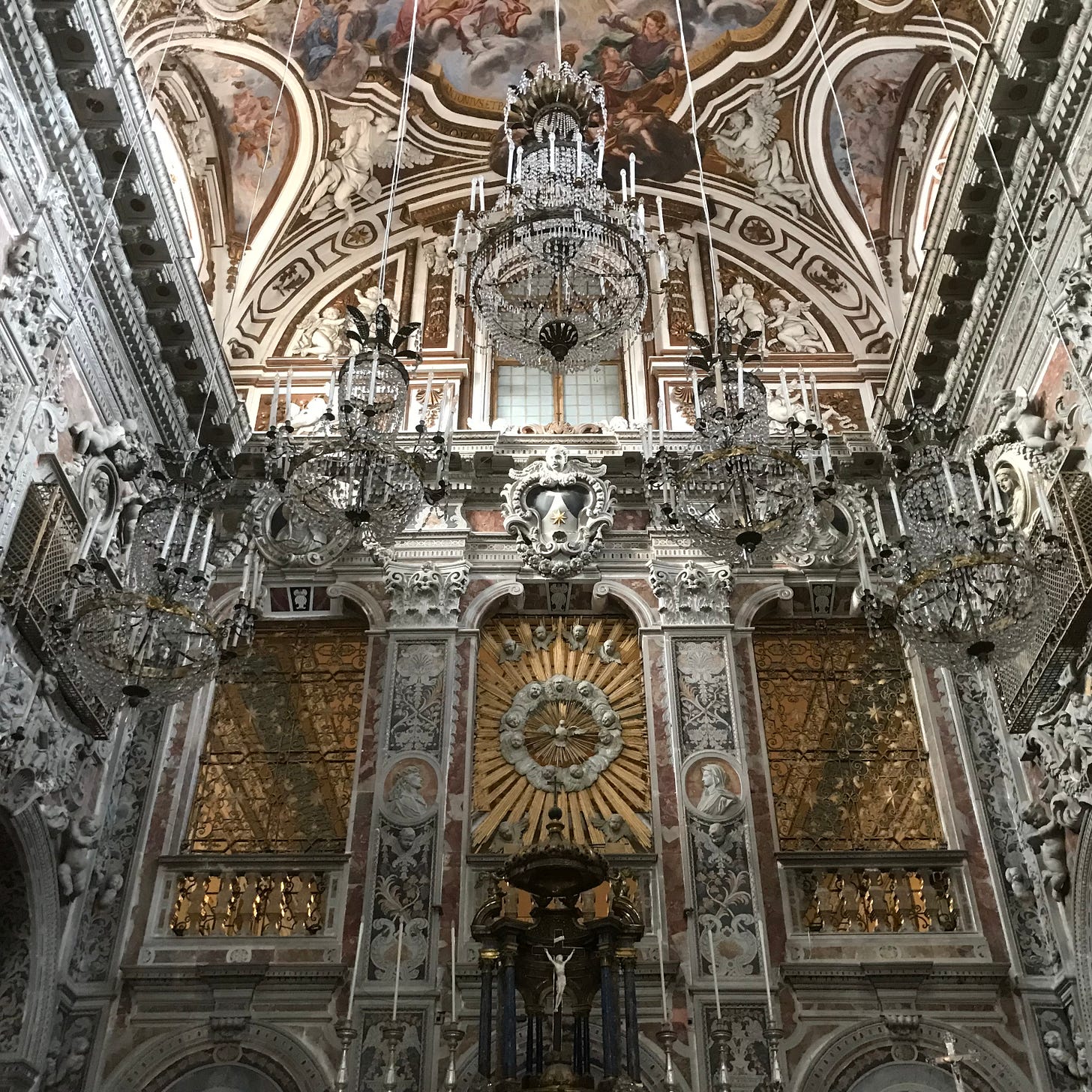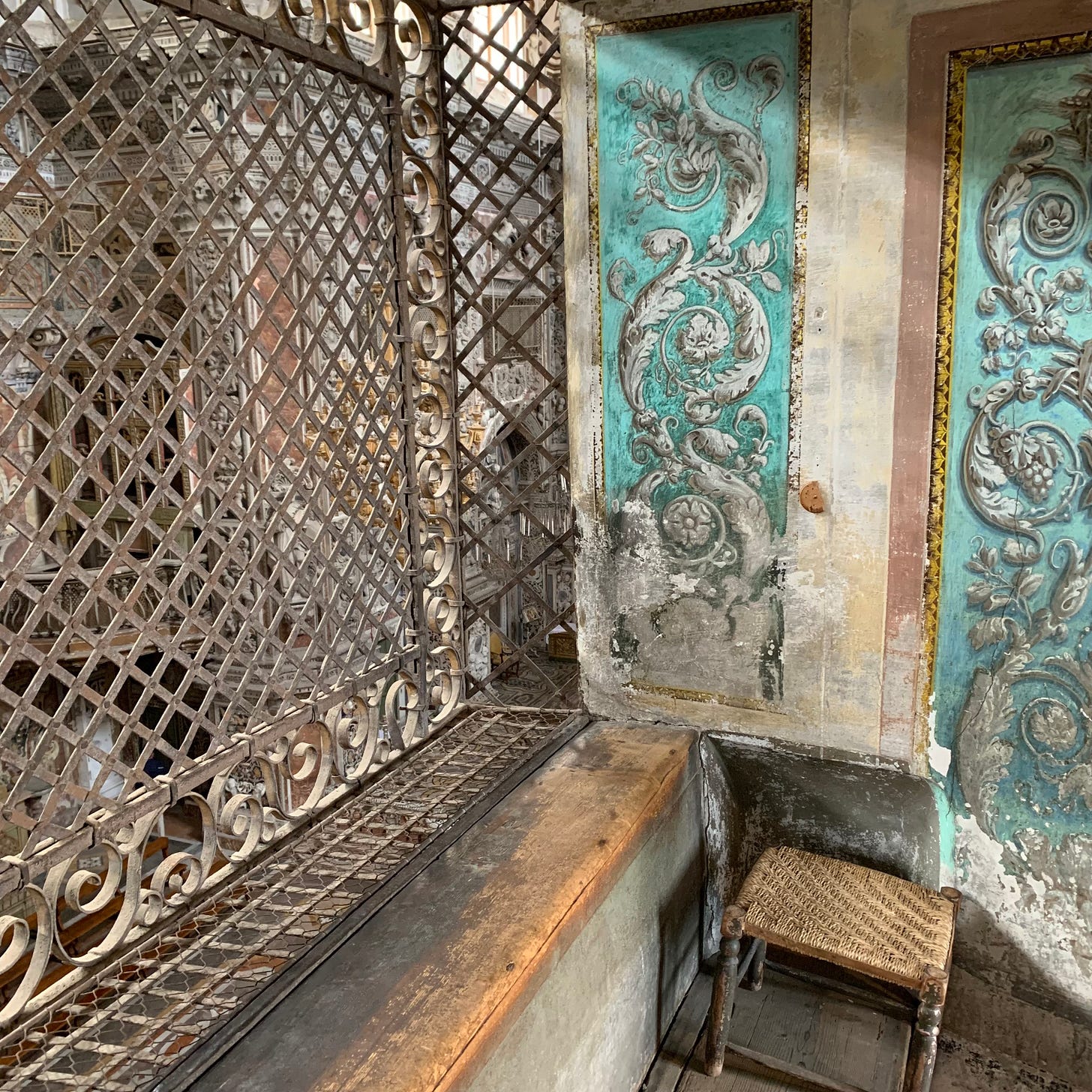# 23 Why Sicilian Marzipan Tastes Bittersweet in Autumn
On grief and the confectionery of Santa Caterina in Palermo
For days, I’ve been craving marzipan, the sweet almond treat from Sicily. Ever since the first autumn chill permeated the air and the leafs began to change color, I longed for this comfort confectionery. Autumn is my favorite time of the year, but it is also the season of dying and therefore of grief.
I grew fond of marzipan in my youth. In the Netherlands, where we celebrate December 5th as Saint Nicolas Day, we traditionally consume all sorts of seasonal sweets. The most popular are probably kruidnootjes, coin-sized cookies made from speculaas, which is short-biscuit dough mixed with pepper, cinnamon, ginger, cloves, cardamom and nutmeg. We also pack away chocolate letters, chocolate coins, pastel-colored fruit-flavored Santa-shaped meringues, and my personal favorite: marzipan.
But the older I got, the less I liked sweets, or perhaps I should say, the more the quality of the marzipan seemed to deteriorate, becoming overly sugary instead of flavorful, and I’d almost forgotten this treat until I tasted it again three years ago.
The Church of Santa Caterina d’Alessandria
In October 2021, three months after my mother’s death, I came to Palermo, Italy, for the second time in my life. I felt rather lost, unfocused, and unsure of where my life was going.
One day, on impulse, I bought a ticket and stepped into the church of Santa Caterina d’Alessandria. Or Saint Catherine of Alexandria as she is known in English. Caterina was a well-educated young woman of noble blood and lived in Egypt in the third century. After she was murdered for being a Christian under Roman rule, she became the patron saint of scholars and philosophers. And thus of me.
Palermo has many churches that are more famous and architecturally more impressive than the church of Santa Caterina, but this church would become my favorite because of where it led me in the end.
The church, built from 1566 to 1596, is gorgeous yet appeared a bit stylistically confused, overly ornate, mixing renaissance, baroque, and rococo features. Intriguing were the small openings in the wall between the church and the adjacent monastery that allowed nuns to take communion during Holy Mass and pass items back and forth. The nuns, I learned, were not allowed inside the church, except for in the upper choir gallery, which I would later visit.
A narrow staircase invited me to climb to the church’s vaulted roof where I stepped outside. From the terraces, I gazed out over Palermo, enjoying the magnificent views. Even more special, though, was looking down into the church from the chapel’s dome windows—a god’s perspective.
The Monastery of Santa Caterina d’Alessandria
After I’d seen enough of the church’s glitter, I entered the monastery, where Dominican nuns lived for seven hundred years (1311-2014).
They slept in tiny bare rooms that were aptly called cells. Oil lamps remained lit all night as rule required—so nobody could sneak around in the dark? Each nun had a single bed, a small study desk, and a wax baby Jesus in a glass case.
The nuns kept themselves completely separate from the rest of society. They entered the church only from elevated areas that communicated with the monastery. I climbed up to the large choir behind the main altar, which had been their domain. The nuns came together there to recite or pray for hours. During Holy Mass they sat on rattan stools high above the plebs and behind metal grids. Obscured from view, they offered their singing voice to the worshippers below.
The Confectionery of Santa Caterina d’Alessandria
A bit melancholic from imagining the isolated lives of these nuns, yet also a tad jealous of how they each had a room of their own with a desk, I crossed the monastery’s courtyard. In another side of the stone building, I climbed to the top floor where "I segreti del Chiostro" were kept—the secrets of the cloister.
In Medieval times, the monastery had apparently earned money by baking and selling sweets, and the old secret recipes of the nuns had been carefully preserved. Now, the confectionery was open to the public.
Most pastries and cookies were off-limits for me, gluten-intolerant as I am. But I didn’t care, because there was an entire table full of fruit-shaped marzipan.
Although I wasn’t entirely conscious of the level of my grief, I knew I’d brought myself here for a reason. A dolceria is a place where you go when the bitterness of life puts you in need of sweets.
I bought three small marzipan figs and took my treat to the courtyard, where I found a bench beneath the citrus trees. What happened next was intense and magical, and I’ve tried to capture it in the passage below.
Marzipan
Not as thrilling as an arrabbiata, not as erotic as bitter chocolate, not as invigorating as a lemon sorbet on a summer afternoon, but known like your husband’s eyes and rich like gold is the taste of the marzipan fruits made by the dolceria of the Santa Caterina monastery in Palermo, Sicily, where the current pastry chefs use the hand-me-down recipes of the nuns who used to live there in little barred rooms with little square desks and little baby Jesuses on makeshift glass altars to produce a rich variety of traditional cakes and crunchy cannoli filled with sheep-cheese ricotta and sesame cookies and in the fall, when it’s the season, a collection of marzipan fruit—peaches, prickly pears, persimmons, figs, everything—all perfectly rendered in size, color, and shape, and of which you need to take only one bite, there in the monastery courtyard under the citrus trees, to bring tears to your eyes and be taken back to that innocent time from before your parents’ divorce, before your parents’ deaths, when you were still a child and not yet a girl, and remember how your parents left marzipan fruits in the shoes that your brother and you had put near the door in the hope that Saint Nicolas would come by for a visit during your sleep to take your carrots for his white horse and leave sugary treats for you in exchange, treats that didn’t taste as nourishing as Oma’s apple pie, not as warming as your father’s barbecued potatoes, not as forbidden as your mother’s ham-filled croissants, but that tasted like goodness itself, as if the sweet almond paste melting on your tongue told the story of a benevolent world where you could trust everyone and would never find yourself crying alone in a monastery courtyard in the fall feeling both loved and abandoned, orphaned in more than one way.
“Marzipan” was first published in The Journal of Compressed Creative Arts.
Practical Information
I cannot guarantee that a visit to the church, monastery, and confectionery of Santa Caterina will be a comfort to everyone in times of grief, but I promise it’s a place worth seeing.
For more information on opening times and entry fees etcetera, please visit the Santa Caterina website.
You’d be happy to know that you can visit the confectionery for free during the monastery’s opening hours. I bought my treasured marzipan several times a week.
If you cannot travel to Palermo, but would like to see and know more, please read the illustrated Santa Caterina brochures in English.
Related Posts
If you enjoyed this post, you might also be interested in reading:
Time to Say Goodbye
Fog has absorbed the castle today and the heating grumbled to life for the first time this season. I have yet to find marzipan in Bracciano, but I’m pretty sure I’ll find some in Rome next time I take the train.
All my best,
Claire
P.S. What is your comfort food in times of grief?













Beautiful. A lesson that life & death are two sides of the same coin. As the essence of the nuns lives on in the marzipan, just as your parents live on through your writing.
Claire, your beautiful piece of writing on marzipan really touched my heart. Thank you for sharing it.